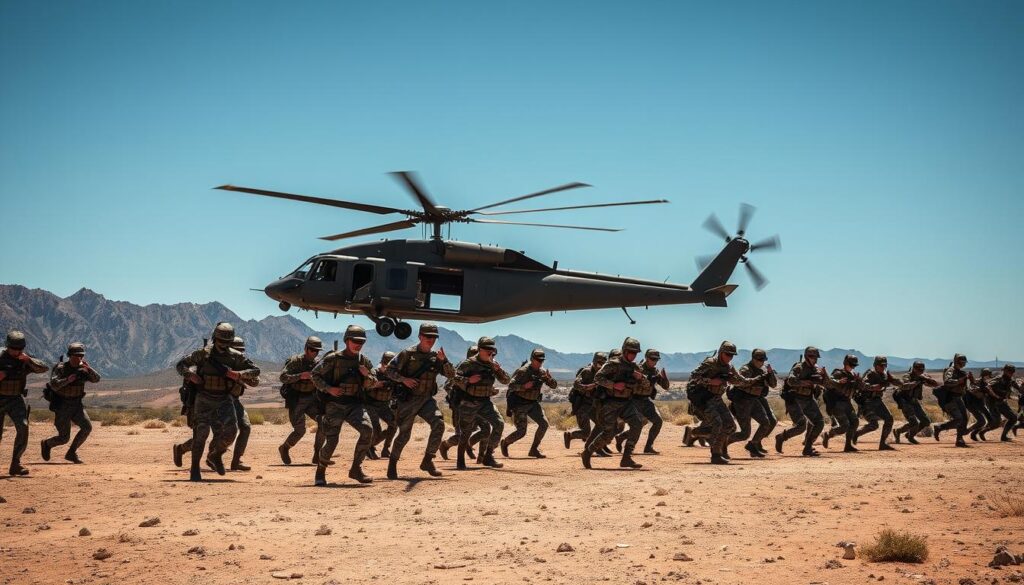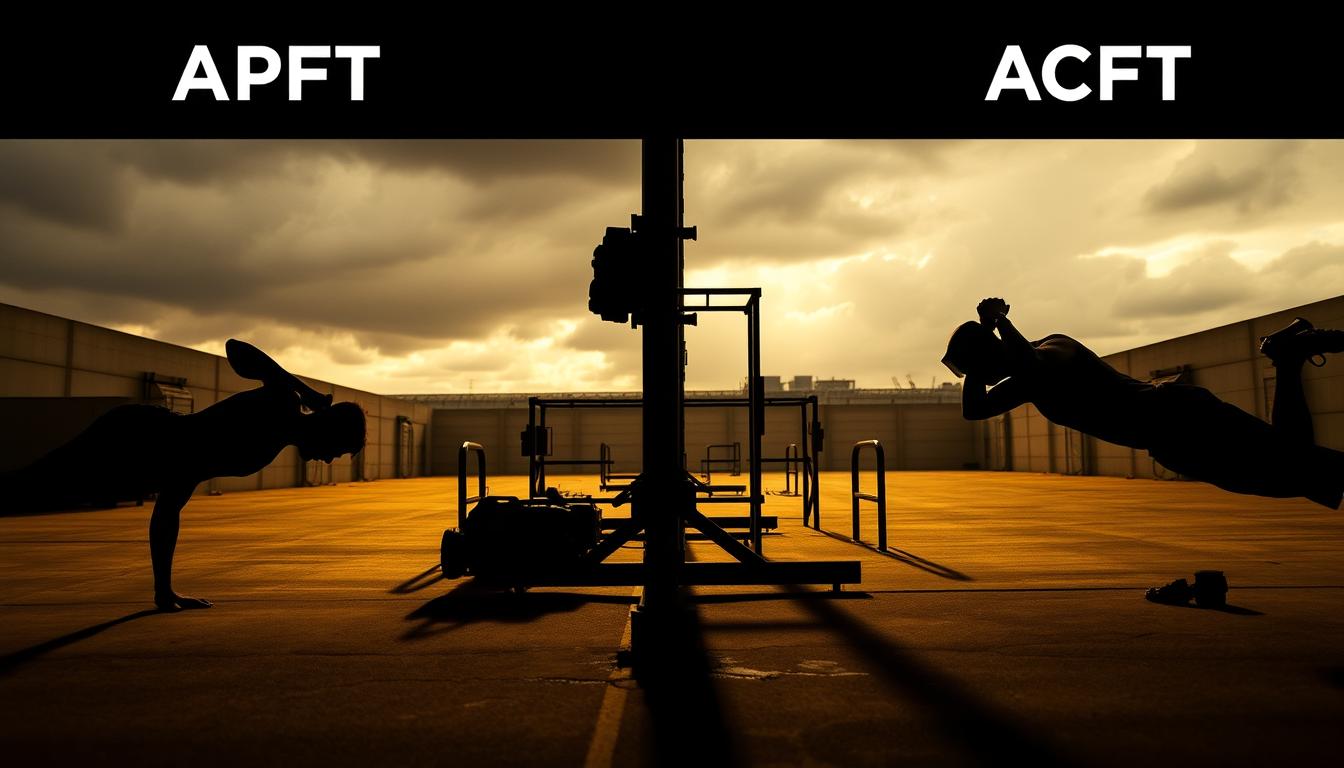The military landscape evolves, and so does how soldiers are tested for fitness. The traditional Physical Fitness Test has long been key to military readiness. But is it still enough?
The Combat Fitness Test brings a big change. It looks at more than just physical fitness. It checks strength, power, agility, and endurance. What are the main differences between these tests, and how do they affect soldier readiness?
Key Takeaways
- The new Combat Fitness Test assesses a broader range of physical abilities.
- The traditional Physical Fitness Test is being replaced by a more comprehensive test.
- The changes reflect the military’s efforts to improve soldier readiness.
- The new test includes events such as deadlift, leg tuck, and standing power throw.
- The implications of the new test on soldier readiness are significant.
Overview of the APFT and ACFT
The Army Physical Fitness Test (APFT) and the Army Combat Fitness Test (ACFT) have a rich history. The APFT started in 1980. It tested muscular endurance and heart health through push-ups, sit-ups, and a two-mile run.
But, the APFT didn’t fully measure combat readiness. General James McConville said, “The APFT was not designed to measure a soldier’s ability to perform in combat, leading to the ACFT’s creation.”
History of the Army Physical Fitness Test
The APFT aimed to keep soldiers fit. It had three parts: push-ups, sit-ups, and a two-mile run. Each was scored based on age and gender. It was simple and used little equipment, making it Army-wide.
Introduction of the Army Combat Fitness Test
The ACFT was made to fix the APFT’s flaws. It includes six events: the APFT’s three, plus deadlifts, standing power throws, and hand-release push-ups. It aims to better predict soldier performance in combat.
The ACFT marks a big change in Army fitness, focusing on real-world readiness. It tests strength, power, agility, and endurance. This makes it a more complete test of a soldier’s fitness.
Key Components of the APFT
The APFT was a key test for soldiers’ fitness. It had several parts to check their physical readiness. The test focused on basic but important fitness aspects.
APFT Events and Scoring
The APFT had three main events: push-ups, sit-ups, and a two-mile run. Each event tested different fitness areas. Push-ups checked upper body strength, sit-ups looked at core strength, and the two-mile run tested heart health.
Scoring was based on age and gender to make it fair. The highest score was 300 points, with 100 points for each event. Soldiers had to meet a minimum score in each to pass. For more Army fitness standards, visit https://www.army.mil/aft.
| Event | Maximum Points | Minimum Passing Score |
|---|---|---|
| Push-ups | 100 | 60 (varies by age and gender) |
| Sit-ups | 100 | 60 (varies by age and gender) |
| Two-mile Run | 100 | 60 (varies by age and gender) |
Standards for Different Age Groups
The APFT standards changed with age and gender. Younger soldiers were expected to do more push-ups and sit-ups and run faster. This made the test fair for all soldiers.
“The APFT was designed to be a simple, efficient measure of a soldier’s physical fitness. While it had its limitations, it served as a foundational tool for assessing soldier readiness.”

In conclusion, the APFT was key in Army fitness tests. It provided a clear measure of physical readiness. Knowing about it helps us see how fitness tests have evolved.
Key Components of the ACFT
The ACFT tests a range of physical skills needed in combat. It’s a big change from the old test. Now, soldiers face different challenges in various events.
ACFT Events and Scoring
The ACFT has six events: deadlift, leg tuck, sprint-drag-carry, two-mile run, standing power throw, and hand-release push-ups. Each event tests a different part of physical fitness.
The deadlift tests strength by lifting heavy weights. The leg tuck checks muscular endurance. The sprint-drag-carry event tests agility and power.
The two-mile run checks cardiovascular endurance. The standing power throw tests explosive power. Hand-release push-ups evaluate upper body strength and endurance.
Each event is scored based on performance. The highest scores are for the best performances. The scoring is fair for all soldiers, regardless of gender.
New Fitness Standards and Requirements
The ACFT sets new fitness standards for modern warfare. Soldiers must meet a minimum score in each event to pass.
| Event | Description | Minimum Score |
|---|---|---|
| Deadlift | Lifting a heavy weight from the ground to a standing position | 60 lbs |
| Leg Tuck | Hanging from a bar and tucking legs up | 1 repetition |
| Sprint-Drag-Carry | A multi-part event testing agility and strength | Completion within a set time |
| Two-Mile Run | Running two miles as fast as possible | Under 21 minutes |
| Standing Power Throw | Throwing a heavy ball backwards over the head | 4.5 meters |
| Hand-Release Push-ups | Performing push-ups with a pause at the bottom | 10 repetitions |

Major Differences Between APFT and ACFT
The Army has changed how it tests soldier fitness from APFT to ACFT. This change aims to make fitness tests more complete. It prepares soldiers for today’s combat better.
Changes in Physical Events
The ACFT has new events that the APFT didn’t. The APFT had push-ups, sit-ups, and a 2-mile run. The ACFT adds:
- Deadlifts
- Standing Power Throw
- Sprint-Drag-Carry
- Plank
- 2-mile run
These new events test strength, power, agility, and endurance. They give a fuller picture of a soldier’s fitness.
Scoring Adjustments and Rationale
The ACFT has a new scoring system. It awards points for each event, up to 100 points. This means a soldier can get a total of 600 points.
The scoring change aims to measure soldier performance better. It encourages soldiers to be good in many physical areas. This helps soldiers be ready and perform well.
In summary, the APFT and ACFT changes are big. They show the Army’s effort to keep its fitness tests up to date. The new events and scoring help soldiers face combat better. They also keep the Army effective.
Impact on Soldier Readiness and Training
The Army is changing how it tests soldier fitness with the ACFT. It now looks at the needs of today’s combat. This change will affect how soldiers train and get ready for duty.
Enhancing Soldier Performance
The ACFT aims to improve soldier readiness by checking more physical skills. It looks at strength, power, agility, and endurance. These are key for soldiers to do their jobs well in different situations.
The test includes the deadlift, hand-release push-up, and sprint-drag-carry. This gives a full picture of a soldier’s physical skills. It helps soldiers get ready for combat’s physical challenges, making them more ready and skilled.
Training Adjustments for the New Test
Soldiers need to change their training to fit the ACFT’s new standards. They should focus on functional fitness like strength, agility, and endurance exercises. For tips on getting ready for the ACFT and Army fitness tests, check out preparing for basic training.
Training might include plyometric exercises, resistance training, and conditioning drills. These help soldiers get fitter and ready for the ACFT’s challenges.
Conclusion and Future of Army Fitness Assessments
The Army is moving from the Army Physical Fitness Test (APFT) to the Army Combat Fitness Test (ACFT). This change focuses on a wider range of physical skills. As the Army keeps working on the ACFT, more changes are expected to make the test better at checking soldier fitness.
The ACFT tests strength, power, and endurance to get soldiers ready for today’s wars. A 2023 study found that better ACFT scores mean healthier body fat and lower health risks. The Army will keep improving the ACFT to keep it a good test of soldier fitness.
The Army will keep watching and tweaking fitness tests to prepare soldiers for today’s wars. The switch from the APFT to the ACFT shows how fitness tests are changing. The ACFT is a more detailed way to check if soldiers are fit for duty.


